Lyons W.C. (ed.). Standard handbook of petroleum and natural gas engineering.2001- Volume 1
Подождите немного. Документ загружается.

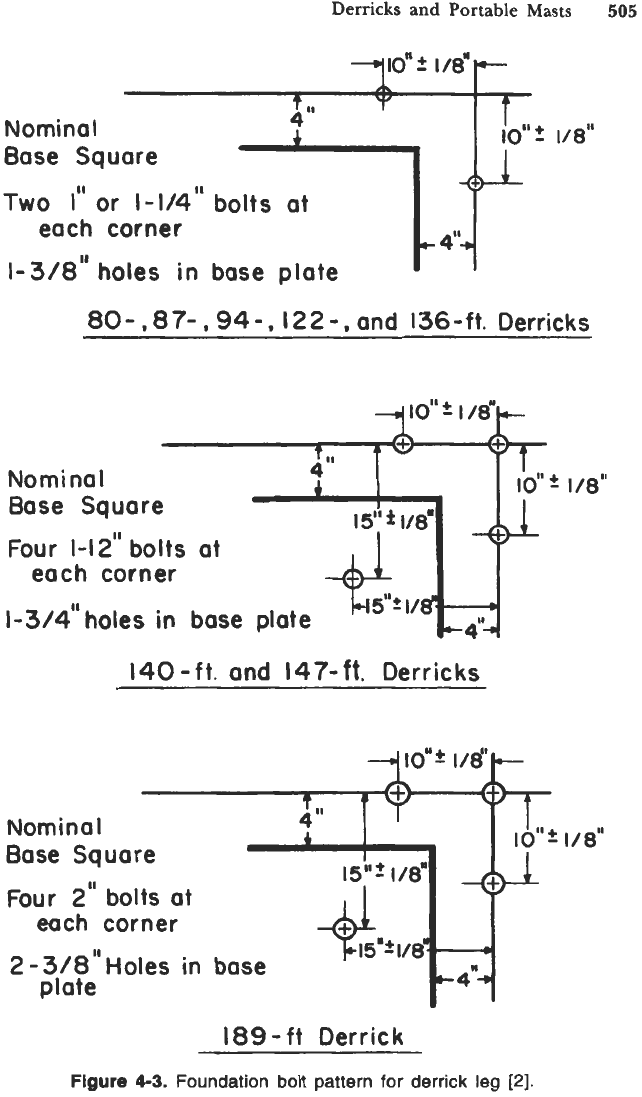
Derricks
and
Portable
Masts
505
TO"
2
118"
rC-
Two
I"
or
l-l/4"
bolts at
Nominal
Base Square
1-3/8"
holes in base plate
each corner
80-
.87-,
94-,
122-,
and
136-ft.
Derricks
Nominal
Base Square
Four
1-12''
bolts at
each corner
1-3/4"holes in base plate
140
-ft.
and
147-ft.
Derricks
Nominal
:
Base Square
Four
2''
bolts
at
each
corner
2-3/8"Holes in base
plate
15":
1/8"
*
4"-,
189
-ft Derrick
~~ ~
Figure
4-3.
Foundation
bolt
pattern
for
derrick leg
[2].
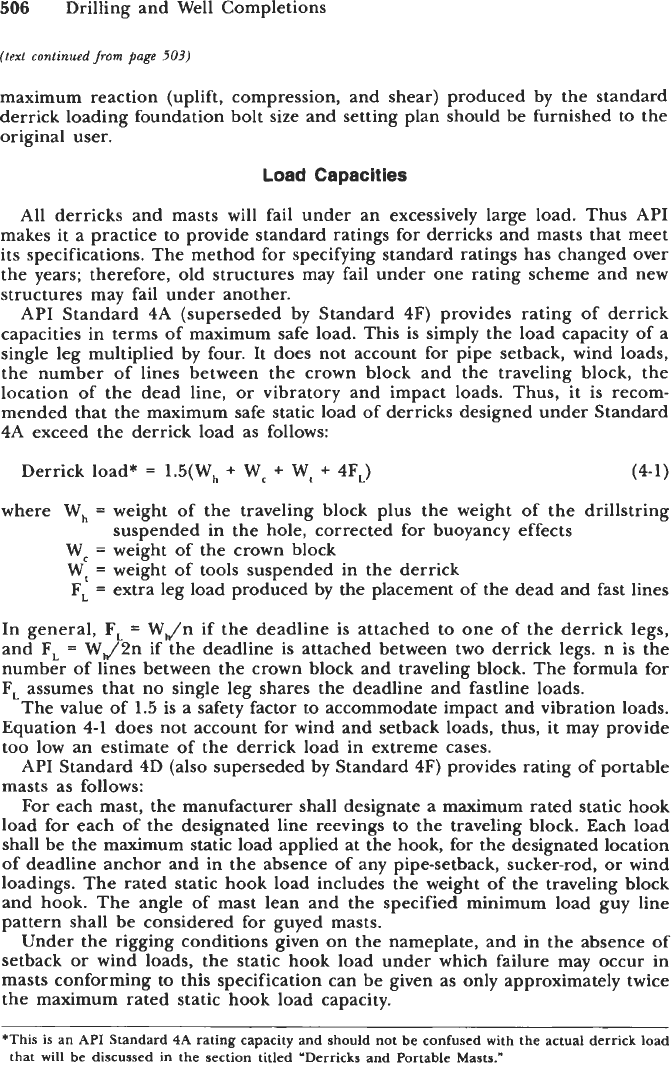
506
Drilling and Well Completions
(text
continued
from
page
503)
maximum reaction (uplift, compression, and shear) produced by the standard
derrick loading foundation bolt size and setting plan should be furnished to the
original user,
Load
Capacities
All derricks and masts will fail under an excessively large load. Thus API
makes it a practice to provide standard ratings for derricks and masts that meet
its specifications. The method for specifying standard ratings has changed over
the years; therefore, old structures may fail under one rating scheme and new
structures may fail under another.
API Standard 4A (superseded by Standard 4F) provides rating of derrick
capacities in terms of maximum safe load. This is simply the load capacity of a
single leg multiplied by four. It does not account for pipe setback, wind loads,
the number of lines between the crown block and the traveling block, the
location of the dead line,
or
vibratory and impact loads. Thus, it is recom-
mended that the maximum safe static load of derricks designed under Standard
4A exceed the derrick load as follows:
Derrick load*
=
1.5(Wh
+
Wc
+
Wt
+
4F,)
(4-1)
where
W,
=
weight of the traveling block plus the weight of the drillstring
suspended in the hole, corrected for buoyancy effects
Wc
=
weight of the crown block
W,
=
weight of tools suspended in the derrick
F,
=
extra leg load produced by the placement of the dead and fast lines
In general, F,
=
WJn if the deadline is attached to one of the derrick legs,
and
F,
=
WJPn if the deadline is attached between two derrick legs. n is the
number of lines between the crown block and traveling block. The formula for
F,
assumes that no single leg shares the deadline and fastline loads.
The value of
1.5
is a safety factor to accommodate impact and vibration loads.
Equation
4-1
does not account for wind and setback loads, thus, it may provide
too low an estimate
of
the derrick load in extreme cases.
API Standard 4D (also superseded by Standard 4F) provides rating of portable
masts as follows:
For each mast, the manufacturer shall designate a maximum rated static hook
load for each
of
the designated line reevings to the traveling block. Each load
shall be the maximum static load applied at the hook, for the designated location
of deadline anchor and in the absence of any pipe-setback, sucker-rod,
or
wind
loadings. The rated static hook load includes the weight
of
the traveling block
and hook. The angle of mast lean and the specified minimum load guy line
pattern shall be considered for guyed masts.
Under the rigging conditions given on the nameplate, and in the absence of
setback
or
wind loads, the static hook load under which failure may occur in
masts conforming to this specification can be given as only approximately twice
the maximum rated static hook load capacity.
*This is an
API
Standard
4A
rating capacity and should
not
be confused with the actual derrick load
that will be discussed in the section titled "Derricks and Portable Masts."
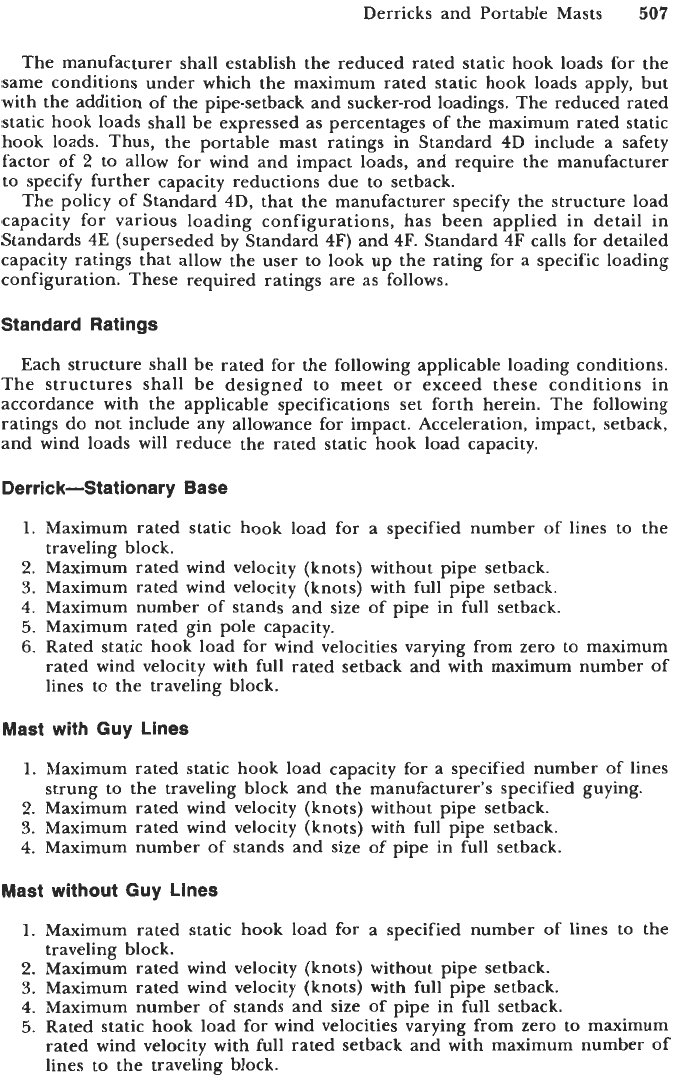
Derricks
and
Portable Masts
507
The manufacturer shall establish the reduced rated static hook loads for the
same conditions under which the maximum rated static hook loads apply, but
with the addition of the pipe-setback and sucker-rod loadings. The reduced rated
static hook loads shall be expressed as percentages of the maximum rated static
hook loads. Thus, the portable mast ratings in Standard 4D include a safety
factor of
2
to allow for wind and impact loads, and require the manufacturer
to specify further capacity reductions due to setback.
The policy of Standard 4D, that the manufacturer specify the structure load
capacity for various loading configurations, has been applied in detail in
Standards 4E (superseded by Standard 4F) and 4F. Standard 4F calls for detailed
capacity ratings that allow the user to look up the rating for a specific loading
configuration. These required ratings are as follows.
Standard Ratings
Each structure shall be rated for the following applicable loading conditions.
The structures shall be designed to meet or exceed these conditions in
accordance with the applicable specifications set forth herein. The following
ratings do not include any allowance for impact. Acceleration, impact, setback,
and wind loads will reduce the rated static hook load capacity.
Derrlck-Stationary Base
1.
Maximum rated static hook load for a specified number of lines to the
2.
Maximum rated wind velocity (knots) without pipe setback.
3.
Maximum rated wind velocity (knots) with full pipe setback.
4.
Maximum number of stands and size of pipe in full setback.
5.
Maximum rated gin pole capacity.
6.
Rated static hook load for wind velocities varying from zero to maximum
rated wind velocity with full rated setback and with maximum number of
lines to the traveling block.
traveling block.
Mast with Guy Lines
1.
Maximum rated static hook load capacity for a specified number of lines
strung to the traveling block and the manufacturer’s specified guying.
2.
Maximum rated wind velocity (knots) without pipe setback.
3.
Maximum rated wind velocity (knots) with full pipe setback.
4. Maximum number of stands and size of pipe in full setback.
Mast wlthout Guy Lines
traveling block.
1.
Maximum rated static hook load for a specified number
of
lines to the
2.
Maximum rated wind velocity (knots) without pipe setback.
3.
Maximum rated wind velocity (knots) with full pipe setback.
4.
Maximum number of stands and size
of
pipe in full setback.
5.
Rated static hook load for wind velocities varying from zero to maximum
rated wind velocity with full rated setback and with maximum number of
lines to the traveling block.
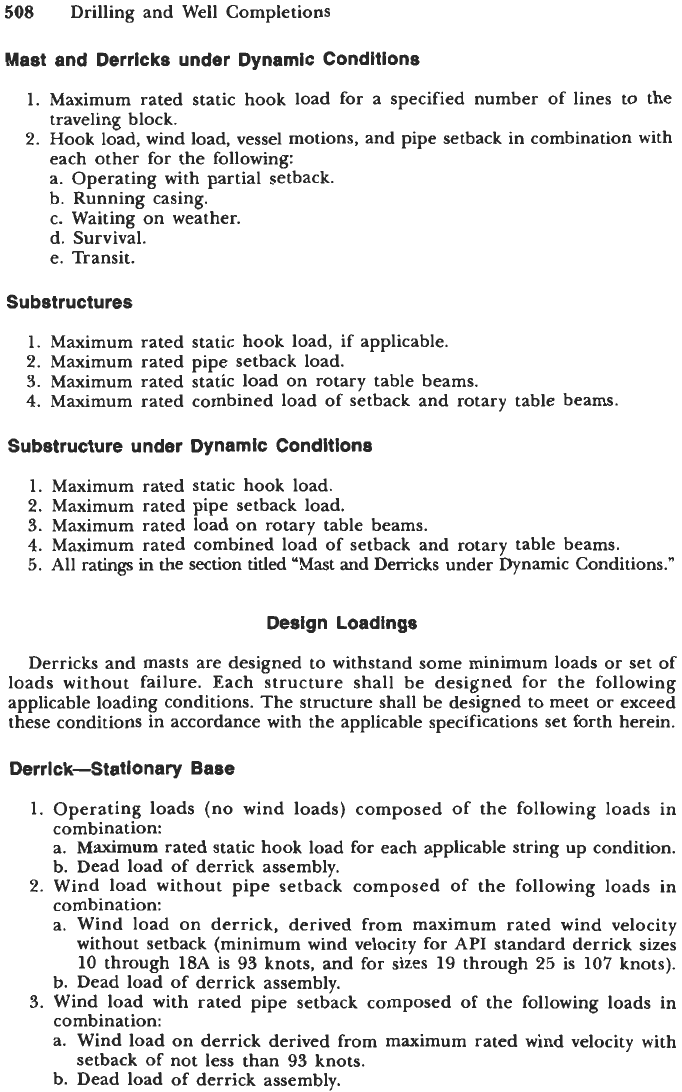
508
Drilling
and
Well Completions
Mast and Derricks under Dynamic Conditions
1.
Maximum rated static hook load for a specified number of lines to the
2.
Hook load, wind load, vessel motions, and pipe setback in combination with
traveling block.
each other for the following:
a. Operating with partial setback.
b. Running casing.
c. Waiting on weather.
d.
Survival.
e.
Transit.
Substructures
1.
Maximum rated static hook load, if applicable.
2.
Maximum rated pipe setback load.
3.
Maximum rated static load on rotary table beams.
4.
Maximum rated combined load of setback
and
rotary table beams.
Substructure under Dynamic Conditions
1.
Maximum rated static hook load.
2.
Maximum rated pipe setback load.
3.
Maximum rated load on rotary table beams.
4.
Maximum rated combined load of setback and rotary table beams.
5.
All ratings
in
the section titled “Mast and Derricks under Dynamic Conditions.”
Design Loadings
Derricks
and
masts are designed to withstand some minimum loads
or
set of
loads without failure. Each structure shall be designed for the following
applicable loading conditions. The structure shall be designed to meet or exceed
these conditions in accordance with the applicable specifications set forth herein.
Derrick-Stationary Base
1.
Operating loads (no wind loads) composed of the following loads in
combination:
a. Maximum rated static hook load for each applicable string up condition.
b.
Dead load
of
derrick assembly.
2.
Wind load without pipe setback composed of the following loads in
combination:
a. Wind load on derrick, derived from maximum rated wind velocity
without setback (minimum wind velocity for
API
standard derrick sizes
10
through 18A is
93
knots, and for sizes
19
through
25
is
107
knots).
b. Dead load of derrick assembly.
3.
Wind load with rated pipe setback composed of the following loads in
combination:
a.
Wind load on derrick derived from maximum rated wind velocity with
b. Dead load
of
derrick assembly.
setback of not less than
93
knots.

Derricks
and
Portable Masts
509
c. Horizontal load at racking platform, derived from maximum rated wind
velocity with setback of not less than
93
knots acting on full pipe
setback.
d. Horizontal load at racking platform from pipe lean.
Mast with Guy
Lines
1.
Operating loads (no wind load) composed of the following loads in
combination:
a. Maximum rated static hook load for each applicable string up condition.
b. Dead load of mast assembly.
c. Horizontal and vertical components of guy line loading.
2.
Wind loads composed of the following loads in combination:
a. Wind load
on
mast, derived from a maximum rated wind velocity with
b. Dead load of mast assembly.
c.
Horizontal loading at racking board, derived from a maximum rated
wind velocity with setback of not less than
60
knots, acting on full pipe
setback.
setback
of
not less than
60
knots.
d. Horizontal and vertical components
of
guy line loading.
e. Horizontal and vertical loading at rod board, derived from a maximum
rated wind velocity with setback of not less than
60
knots, acting on
rods in conjunction with dead weight of rods.
3.
Wind loads composed of the following loads in combination:
a. Wind load on mast, derived from a maximum rated wind velocity with
b. Dead load of mast assembly.
c.
Horizontal loading at racking platform, derived from a maximum rated
wind velocity with setback of not less than
60
knots, acting on full pipe
setback.
setback of not less than
60
knots.
d. Horizontal and vertical components of guy line loading.
4.
Wind loads composed of the following loads in combination:
a. Wind load on mast derived from
a
maximum rated wind velocity without
b. Dead load of mast assembly.
c. Horizontal and vertical components of guy line loading.
5.
Erection loads (zero wind load) composed of the following loads in
combination:
a. Forces applied to mast and supporting structure created by raising or
b. Dead load of mast assembly.
6.
Guy line loading (assume ground anchor pattern consistent with manu-
facturer’s guying diagram shown on the nameplate).
a. Maximum horizontal and vertical reactions from conditions of loading
applied to guy line.
b. Dead load of guy line.
c. Initial tension in guy line specified by mast manufacturer.
setback
of
not less than
60
knots.
lowering mast.
Mast
without Guy
Lines
1.
Operating loads composed of the following loads in combination:
a. Maximum rated static hook load for each applicable string up condition.
b.
Dead load of mast assembly.
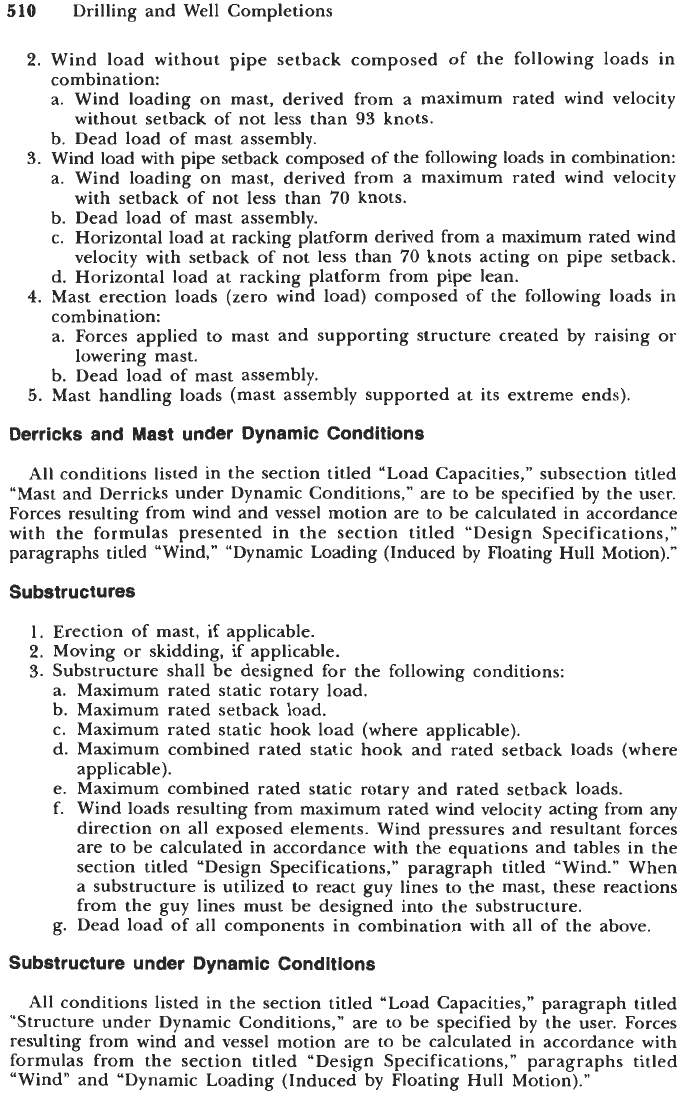
510
Drilling and Well Completions
2.
Wind load without pipe setback composed of the following loads in
combination:
a. Wind loading on mast, derived from a maximum rated wind velocity
b. Dead load of mast assembly.
3.
Wind load with pipe setback composed of the following loads in combination:
a. Wind loading on mast, derived from a maximum rated wind velocity
b. Dead load of mast assembly.
c. Horizontal load at racking platform derived from a maximum rated wind
velocity with setback of not less than
70
knots acting on pipe setback.
d. Horizontal load at racking platform from pipe lean.
4.
Mast erection loads (zero wind load) composed of the following loads in
combination:
a. Forces applied to mast and supporting structure created by raising or
b. Dead load of mast assembly.
without setback of not less than
93
knots.
with setback of not less than
70
knots.
lowering mast.
5.
Mast handling loads (mast assembly supported at its extreme ends).
Derricks and Mast under Dynamic Conditions
All conditions listed in the section titled “Load Capacities,” subsection titled
“Mast and Derricks under Dynamic Conditions,” are to be specified by the user.
Forces resulting from wind and vessel motion are to be calculated in accordance
with the formulas presented in the section titled “Design Specifications,”
paragraphs titled “Wind,” “Dynamic Loading (Induced by Floating Hull Motion).”
Substructures
1.
Erection of mast, if applicable.
2.
Moving
or
skidding, if applicable.
3.
Substructure shall be designed for the following conditions:
a. Maximum rated static rotary load.
b. Maximum rated setback load.
c. Maximum rated static hook load (where applicable).
d. Maximum combined rated static hook and rated setback loads (where
e. Maximum combined rated static rotary and rated setback loads.
f. Wind loads resulting from maximum rated wind velocity acting from any
direction on all exposed elements. Wind pressures and resultant forces
are to be calculated in accordance with the equations and tables in the
section titled “Design Specifications,” paragraph titled “Wind.” When
a substructure is utilized to react guy lines to the mast, these reactions
from the guy lines must be designed into the substructure.
applicable).
g. Dead load of all components in combination with all of the above.
Substructure under Dynamic Conditions
All conditions listed in the section titled “Load Capacities,” paragraph titled
“Structure under Dynamic Conditions,’’ are to be specified by the user. Forces
resulting from wind and vessel motion are to be calculated in accordance with
formulas from the section titled “Design Specifications,” paragraphs titled
“Wind” and “Dynamic Loading (Induced by Floating Hull Motion).”

Derricks and Portable Masts
511
Design Specifications
In addition to withstanding some minimum load or loads (sections titled
“Load Capacities” and “Design Specifications”), derricks and masts that satisfy
API standards must also satisfy certain requirements regarding materials,
allowable stresses, wind, dynamic loading, earthquakes and extremes of temperature.
Materials
The unrestricted material acceptance is not intended since physical properties
are not the sole measure of acceptability. Metallurgical properties, which affect
fabrication and serviceability, must also
be
considered.
Steel.
Steel shall conform to one of the applicable ASTM specifications referred
to
by applicable AISC specifications. Other steels not covered by these specifica-
tions may be used provided that the chemical and physical properties conform
to the limits guaranteed by
the
steel manufacturer. Structural steel shapes having
specified minimum yield less than
33,000
psi shall not be used. Certified mill
test report or certified reports of tests made in accordance with ASTM A6 and
the governing specification shall constitute evidence of conformity with one of
the specifications listed.
Bolts.
Bolts shall conform to one of the applicable SAE, ASTM, or AISC
specifications. Other bolts not covered by these specifications may be used
provided the chemical, mechanical, and physical properties conform to the limits
guaranteed by the bolt manufacturer. Certified reports shall constitute sufficient
evidence of conformity with the specification. Bolts of different mechanical
properties and of the same diameter shall not be mixed on the same drilling
or servicing structure to avoid the possibility of bolts of relatively low strength
being used where bolts of relatively high strength are required.
Welding Electrodes.
Welding electrodes shall conform to applicable
AWS
and
ASTM specifications or other governing codes. Newly developed welding
processes shall use welding electrodes conforming to applicable AWS or other
governing publications. Certified reports shall constitute sufficient evidence of
conformity with the specifications.
Wire Rope.
Wire rope for guy lines or erection purposes shall conform to
API
Specification
9A
“Specification for Wire Rope.”
Nonferrous Materiais.
Nonferrous materials must conform to appropriate
governing codes. Certified reports shall constitute sufficient evidence of
conformity with such codes.
Allowable Stresses
AISC specifications for the design fabrication and erection of structural steel
for buildings shall govern the design of these steel structures (for
AISC
specifications, see the current edition of Steel Construction Manual
of
the
American Institute
of
Steel Construction). Only Part
I
of
the AISC manual, the
portion commonly referred to as elastic design, shall be
used
in determining
allowable unit stresses; use of Part 11, which is commonly referred to as plastic
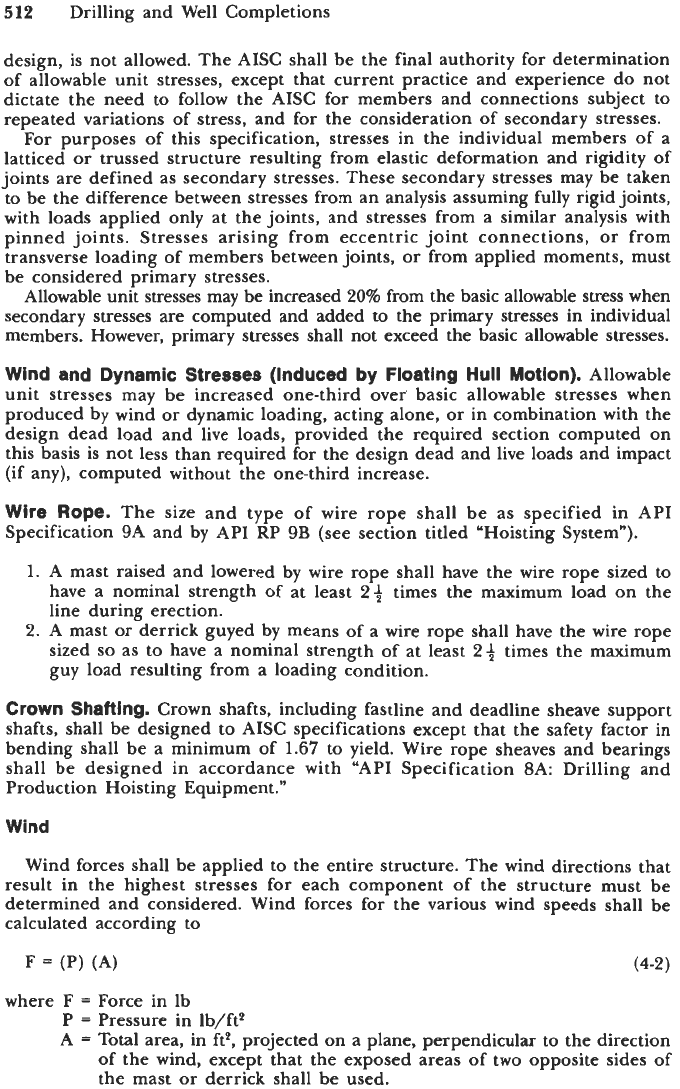
512
Drilling and Well Completions
design, is not allowed. The AISC shall be the final authority for determination
of allowable unit stresses, except that current practice and experience do not
dictate the need to follow the AISC for members and connections subject to
repeated variations of stress, and for the consideration of secondary stresses.
For
purposes of this specification, stresses in the individual members of a
latticed
or
trussed structure resulting from elastic deformation and rigidity of
joints are defined as secondary stresses. These secondary stresses may be taken
to be the difference between stresses from an analysis assuming fully rigid joints,
with loads applied only at the joints, and stresses from a similar analysis with
pinned joints. Stresses arising from eccentric joint connections, or from
transverse loading of members between joints, or from applied moments, must
be considered primary stresses.
Allowable unit stresses
may
be increased
20%
from the basic allowable
stress
when
secondary stresses
are
computed and added
to
the primary stresses
in
individual
members. However, primary stresses shall not exceed the basic allowable stresses.
Wind and Dynamic Stresses (Induced by Floating Hull Motion).
Allowable
unit stresses may be increased one-third over basic allowable stresses when
produced by wind or dynamic loading, acting alone, or in combination with the
design dead load and live loads, provided the required section computed on
this basis
is
not less than required for the design dead and live loads and impact
(if any), computed without the one-third increase.
Wire Rope.
The size and type of wire rope shall be as specified in API
Specification 9A and by
API
RP
9B
(see section titled “Hoisting System”).
1.
A mast raised and lowered by wire rope shall have the wire rope sized to
have a nominal strength of at least
2+
times the maximum load on the
line during erection.
2.
A mast or derrick guyed by means of
a
wire rope shall have the wire rope
sized
so
as to have a nominal strength of at least
24
times the maximum
guy load resulting from a loading condition.
Crown Shafting.
Crown shafts, including fastline and deadline sheave support
shafts, shall be designed to AISC specifications except that the safety factor in
bending shall be a minimum of
1.67
to yield. Wire rope sheaves and bearings
shall be designed in accordance with “API Specification 8A: Drilling and
Production Hoisting Equipment.”
Wind
Wind forces shall
be
applied
to
the entire structure. The wind directions that
result in the highest stresses for each component of the structure must be
determined and considered. Wind forces for the various wind speeds shall be
calculated according to
F
=
(PI
(A)
(4-2)
where
F
=
Force in lb
P
=
Pressure in lb/ft2
A
=
Total area, in ftp, projected on a plane, perpendicular to the direction
of
the wind, except that the exposed areas of two opposite sides of
the mast or derrick shall be used.

Derricks and Portable Masts
513
When pipe or tubing is racked in more than one area, the minimum area
of
setback shall be no less than
120%
of the area on one side; when rods are racked
on
more than one area, the minimum area of rods shall be no less than
150%
of
the area of one side to account for the effect
of
wind on the leeward area
(Figure
4-4).
The
pressure due to wind is
P
=
0.00338
(V;)(C,)(C,)
(4-3)
where
P
=
pressure in. lb/ft4
V,
=
wind velocity in knots
C,
=
height coefficient
Height
(ft)
c,
0-
50
1
.o
50-1
00
1.1
100-1 50
1.2
150-200
1.3
200-250 1.4
NOTE:
In
calculating
the
value
of
A,
If
R
is
greater
than
lSa,
use
R.
If
not,
use
1.5a.
If
T
is
greater
than
1.2b,
use
T.
If
not,
use
1.2b.
Figure
4-4.
Diagram
of
projected area
[9].
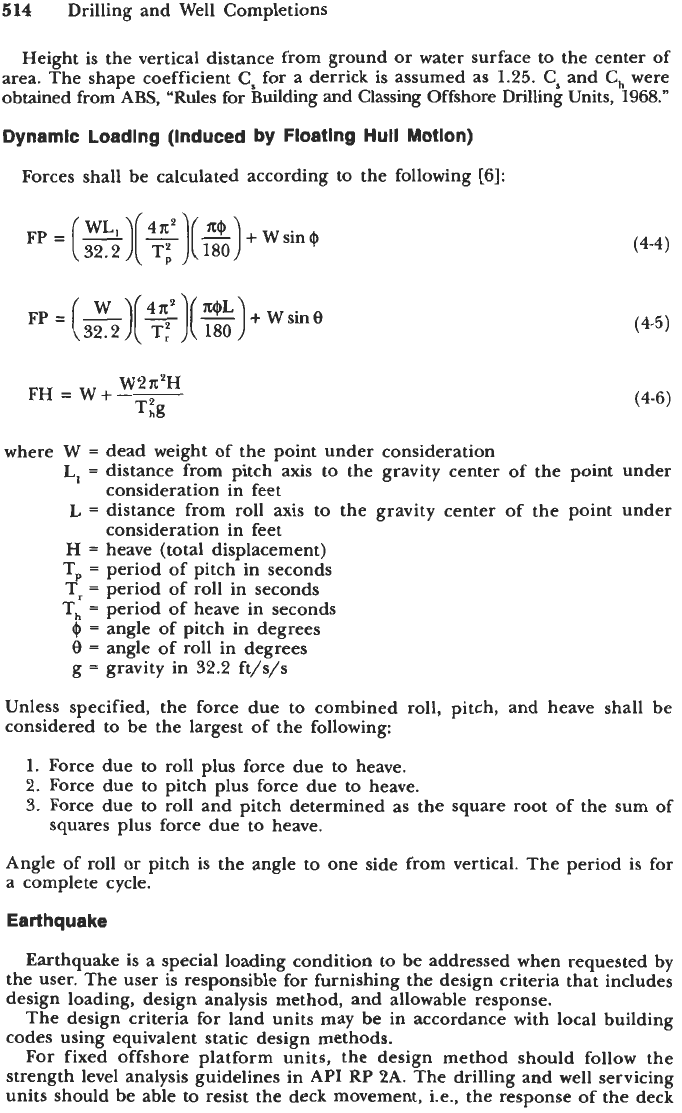
514
Drilling and Well Completions
Height is the vertical distance from ground
or
water surface to the center of
area. The shape coefficient Cs for a derrick is assumed as
1.25.
Cs
and
C,
were
obtained from ABS, "Rules for Building and Classing Offshore Drilling Units,
1968."
Dynamic Loading (Induced by Floating
Hull
Motion)
Forces shall be calculated according to the following
[6]:
FP
=
(&)[
$)(
$)
+
w
sine
(4-5)
where
W
=
dead weight of the point under consideration
L,
=
distance from pitch
axis
to
the gravity center of the point under
consideration in feet
L
=
distance from roll axis to the gravity center of the point under
consideration in feet
H
=
heave (total displacement)
T,
=
period of pitch in seconds
Tr
=
period of roll in seconds
Th
=
period of heave in seconds
I$
=
angle of pitch in degrees
8
=
angle of
roll
in degrees
g
=
gravity in
32.2
ft/s/s
Unless specified, the force due to combined roll, pitch, and heave shall be
considered to be the largest of the following:
1.
Force due
to
roll plus force due
to
heave.
2.
Force due to pitch plus force due to heave.
3.
Force due to roll and pitch determined
as
the square root of the sum of
Angle
of
roll
or
pitch
is
the angle to one side from vertical. The period is for
a complete cycle.
Earthquake
squares plus force due to heave.
Earthquake is a special loading condition to be addressed when requested by
the user. The user is responsible for furnishing the design criteria that includes
design loading, design analysis method, and allowable response.
The design criteria for land units may be in accordance with local building
codes using equivalent static design methods.
For
fixed offshore platform units, the design method should follow the
strength level analysis guidelines in API
RP
2A.
The drilling and well servicing
units should be able to resist the deck movement, i.e., the response
of
the deck
